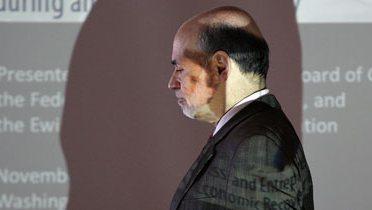Content from the Brookings-Tsinghua Public Policy Center is now archived. Since October 1, 2020, Brookings has maintained a limited partnership with Tsinghua University School of Public Policy and Management that is intended to facilitate jointly organized dialogues, meetings, and/or events.
It is generally agreed that housing bubble of the United States at the turn of this century led to the unprecedented global financial crisis and subsequent great recession. Among many theories which attempt to explain reasons for the real estate bubble and the following financial crisis, the hypothesis of global saving glut suggested by Ben S. Bernanke (2005, 2007, 2009, 2010, 2011), a Distinguished Fellow at Brookings Institution and former Chairman of the Board of Governors of the Federal Reserve System, is a most influential yet controversial one.
Bernanke (2005) raised a concept of global saving glut and initially used it to account for the U.S. current account deficit. Then he (2007a, 2007b) claimed that the global saving glut “played an important role in the decline in long-term rates”. Although Bernanke (2009) did not directly attribute the financial crisis to the global saving glut, he considered that “to achieve more balanced and durable economic growth and to reduce the risks of financial instability, we must avoid ever-increasing and unsustainable imbalances in trade and capital flows”.
In January 2010, Bernanke delivered a keynote speech entitled “Monetary Policy and the Housing Bubble,” at the annual American Economic Association (AEA) meeting, in which he thoroughly discussed adequacy of the Fed’s monetary policy and examined relationship between monetary policy and the rise in housing prices in the first half of the decade. Based on the evidence offered, he (2010a) concluded that the “direct linkages (between monetary policy and housing bubble), at least, are weak.” Moreover, he said, “(monetary) policy during that period—though certainly accommodative (to reduce capital flows)—does not appear to have been inappropriate……What does explain the variability in house price appreciation across countries? In my previous remarks, I have pointed out that capital flows from emerging markets to industrial countries can help to explain asset (housing) price appreciation and low long-term real interest rates in the countries receiving the funds—the so-called global saving glut.”
Bernanke (2010b) reiterated that “because large flows of capital into the United States drove down the returns available on many traditional long-term investments, such as Treasury bonds, investors’ appetite for alternative investments—such as loans to finance corporate mergers or commercial real estate projects—increased greatly in the years leading up to the crisis. These securities too were packaged and sold through the shadow banking system.” Bernanke (2010c) further explained that “a key driver of this ‘uphill’ flow of capital is official reserve accumulation in the emerging market economies that exceeds private capital in-flows to these economies. The total holdings of foreign exchange reserves by selected major emerging market economies… have risen sharply since the crisis and now surpass $5 trillion…China holds about half of the total reserves of these selected economies, slightly more than $2.6 trillion.”
Moreover, Bernanke (2011) pointed out that “the failures of the U.S. financial system in allocating strong flows of capital, both domestic and foreign, helped precipitate the recent financial crisis and global recession…A significant portion of these capital inflows reflected a broader phenomenon that, in the past, I have dubbed the global saving glut. Over the past 15 years or so, for reasons on which I have elaborated in earlier remarks, many emerging market economies have run large, sustained current account surpluses and thus have become exporters of capital to the advanced economies, especially the United States. These in-flows exacerbated the U.S. current account deficit and were also a factor pushing U.S. and global longer-term interest rates below levels suggested by expected short-term rates and other macroeconomic fundamentals.”
In sum, the global saving glut hypothesis contains a cluster of logically articulated arguments: 1) monetary policy of the U.S. Federal Reserve is appropriate prior to the financial crisis during the first decade of this century; 2) the linkage between monetary policy and housing price appreciation across industrial countries including the United States is statistically insignificant and economically weak during this period; 3) the monetary policy is accommodative to cope with capital flows from reserve-rich countries, especially developing and emerging-market nations; and 4) massive accumulation of foreign reserves and consequent capital inflows from these economies to the United States leads to low long-term real rates and housing price bubble, so as to bring about the financial crisis.
However, the literature has far from reached a consensus regarding this important assumption. On the one hand, many authors offered theoretical explanations and presented some empirical evidences in favor of the global saving glut hypothesis from various respects. For example, Caballero, Farhi and Gourinchas (2008) used a formal framework to account for central role of international financial development heterogeneity on the global imbalances and low interest rates. Warnocka and Warnockd (2009) estimated that if there were absent the substantial foreign inflows into U.S. government bonds, the long-term Treasury yield would be 80 basis points higher. Dokko et al. (2009) argued that monetary policy was not a primary factor in the housing bubble and also suspect that tighter monetary policy would not have been the best response to the bubble. Bean et al. (2010) showed that low policy rates only played a modest direct role to the growth in credit and the rise in house prices in the run‐up to the crisis. Poole (2010) pointed out that the federal policies were just supporting actors for the financial crisis but the responsibility rests primarily with the private sector. Kuttner (2012) reviewed empirical studies and concluded that impact of interest rates on house prices appears to be quite modest and the estimated effects are too small to explain the housing boom in the United States and elsewhere over the past decade. Hofmann and Bogdanova (2012) suggested that monetary policy has probably been systematically accommodative globally due to “an asymmetric reaction of monetary policy to the different stages of the financial cycle in core advanced economies, and global behavioral monetary policy spillovers through resistance to
undesired capital flows and exchange rate movements in other countries, especially in EMEs.”
On the other hand, Taylor (2007, 2009, 2010, 2012) argued that excessively low policy rates led to the housing bubble. Based on the statistical analysis, Taylor (2009) concluded that “government actions and interventions caused, prolonged, and worsened the financial crisis. They caused it by deviating from historical precedents and principles for setting interest rates, which had worked well for 20 years”. Seyfried (2010) found that loose monetary policy significantly affected housing price inflation in Ireland, Spain and the United States in the recent years. Rötheli (2010) stated that the easing monetary policy was responsible for the financial crisis and it is necessary to employ monetary policy to restrain financial boom–bust cycles in the future. Mishikin (2011) commended that “although it is far from clear that the Federal Reserve is to blame for the housing bubble, the explosion of microeconomic research, both theoretical and empirical, suggests that there is a case for monetary policy to play a role in creating credit bubbles.” Sá, Towbin and Wieladek (2011) used a panel data of the OECD countries to prove that monetary policy and capital inflows shocks had a significant and positive effect on real house prices, real credit to the private sector and real residential investment. Borio and Disyatat (2011) indicated that it was not global excess saving but credit creation, a defining feature of a monetary economy, which played a key role as main contributor to the financial crisis. Sánchez (2011) suggested that expansionary monetary policy beyond optimal rules during a long-lasting period and policies of artificially promoting credit expansion should be avoided, because they produced inadequate incentives for private sectors. McDonald and Stokes (2013) employed three alternative models and monthly data of the period 1987 to 2010 to reveal that the Federal funds rate in the U.S. had negative impacts on changes of housing prices. Based on panel data of 18 OECD countries from 1920 to 2011, Bordo, and Landon-Lane (2013) documented that loose monetary policy (either an interest rate below the target rate or a money growth rate above the target growth rate) positively affected general asset prices. This result was robust across multiple asset prices and different specifications, and it was present with other alternative explanations such as low inflation or “easy” credit controlled.
Although the above-mentioned researchers explored the issue from different perspectives, there were no decisive and convincing evidence regarding it. Therefore, more studies must be pursued to fully assess validity of the global saving glut assumption. This paper aims to provide additional evidence to verify the global saving glut hypothesis. Section I will broadly evaluate appropriation of the Fed’s monetary policy in line with the Taylor rule by using wide range of data sets. Section II will further document relationship between monetary policy and housing prices across countries. Section III will discuss linkage between the Fed’s monetary policy and foreign reserves of the East Asian export-oriented economies and the Organization of Petroleum Exporting Countries (OPEC) member countries. Section VI will search documentary clues to identify if monetary policy is accommodative to internal or external factors. Finally, Section V will provide concluding remarks.








